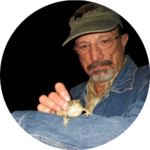As we increasingly confront the environmental consequences of climate change, it is vitally important that natural science museums continue to collect and preserve specimens and objects to document its effects. Because scientific specimens are a record of the occurrence of a species at a particular time and place and contain clues to what their environment was like, natural science collections allow us to analyze past environmental patterns and predict future changes, but our ability to use collections in this way depends on having specimens collected over a long timespan. Continued collecting should be conducted in accordance with standards for equitable biological fieldwork. Although it is important to continue preparing specimens in traditional ways (e.g., dry specimens, skeletons, fluid-preserved specimens), it is equally important to develop new preservation techniques to meet the needs of future research (such as molecular systematics, isotope studies, microbiome research). To accommodate this increase in collection size, institutions should use the principles of preventive conservation to design more efficient collection storage arrays and facilities with stable, passive environments.
 JOHN E. SIMMONS
JOHN E. SIMMONS
Museum Study Instructor, Author
John E. Simmons has a B.A. in Systematics & Ecology and an M.A. in Museum Studies. He began his career as a zookeeper at the Fort Worth Zoological Park before becoming collections manager at the California Academy of Sciences and later at the Natural History Museum at the University of Kansas, where he also served as Director of the Museum Studies Program until 2007. John is the recipient of the Superior Voluntary Service Award from AAM (2001), the Chancellor’s Award for Outstanding Mentoring of Graduate Students from the University of Kansas (2005), the Carolyn L. Rose Award for Outstanding Commitment to Natural History Collections and Management from the Society for the Preservation of Natural History Collections (2011), the Dudley-Wilkinson Award of Distinction from the Registrars Committee of the American Alliance of Museums (2016), and the Spiritus Award for Excellence in Service and Management of Herpetological and Ichthyological Collections from the American Society of Ichthyologists and Herpetologists (2019). John has published more than 150 papers and several books, including Cuidado, Manejo y Conservacion de las Colecciones Biologicas (2005, with Yaneth Munoz-Saba), Fluid Preservation: A Comprehensive Reference (2014), Foundations of Museum Studies: Evolving Systems of Knowledge (2014, with Kiersten Latham), Herpetological Collecting and Collections Management (3rd edition, 2015), Museums: A History (2016), Things Great and Small: Collections Management Policies (2nd edition, 2017), the 6th edition of Museum Registration Methods (with Toni Kiser, 2020), Best Practices in the Preservation and Management of Fluid-Preserved Biological Collections (with Dirk Neumann, Julian Carter, and Oliver Crimmen, 2022), and the chapter on "Collections Management: History, Theory, and Practice" in The International Handbooks of Museum Studies (2015). John runs Museologica (a museum consulting service); teaches museum studies for Michigan State University, the Universidad Nacional de Colombia, and Museum Study LLC; and serves as Associate Curator of Collections at the Earth and Mineral Sciences Museum & Art Gallery at Penn State University.
